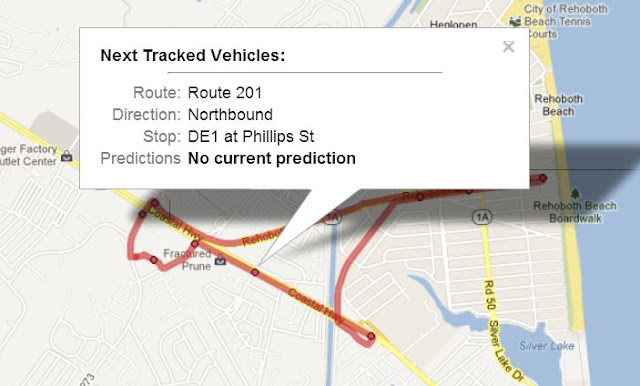I was reading comments at the DelDOT Facebook page the other day. I noticed a comment from someone complaining about his bus leaving 15 minutes late from Rodney Square. I’m sure everyone who uses DART has had that experience more than a few times. I think we usually understand and make allowances for late buses. Traffic is unpredictable, and just one wheelchair boarding can set a schedule back 5 minutes. We get annoyed when our bus isn’t on time, but we understand... kinda.
But what riders find impossible to forgive is when they miss a bus because it left early. There were comments about that, too. The worst of all is when a bus is parked at a transfer point, such as Rodney Square, and after waiting for passengers to board for 5 or 10 minutes it leaves... ahead of schedule. I’ve seen buses leave Rodney Square anywhere from 1 to 6 or more minutes ahead of scheduled departure. And, like the passengers who commented on DelDOT’s page, I’ve missed buses because of such early departures.
An early departure infuriates riders for several reasons:
Personally, I used to see this happen all the time when I transferred from a Route 40 bus to Route 19. I’d usually arrive at Rodney Square in the early evening, usually a little late because Route 40 is often slowed by heavy traffic. I’d rush to find the Route 19 bus, sometimes only to have it pull out early, leaving me in its dust. So I complained to DART, using the complaint feature on its website. And guess what... that driver just kept on leaving early. I’d sit on the bus each evening and time the departure, and more often than not it would be early... one minute, two minutes, three minutes. Not a lot, but just enough to cause people to miss their rides. Since I had complained more than once, I expected the situation to be corrected, but it never was. This specific driver just continued to stick it to the riders with no consequences, so far as I could see.
I wonder about why some drivers tend to do this, to leave early. Do they have watches or clocks on their buses? Are their watches/clocks checked so that they aren’t fast or slow? Some drivers are probably just impatient, or maybe, as with my former Route 19 driver, it’s the last trip of their shift and they want to finish a little early, or use a restroom, or have a meal. But maybe some do this in order to get a jump on their schedules. Is there pressure on drivers to get to their destinations on time, such that they feel pressured to take little shortcuts like leaving early? I wish I knew.
This situation has been going on for years now and is still going on, despite passenger complaints. What’s wrong with DART management, with its training and supervision, that it has still not been corrected? This is not a sign of a well-run transit agency.
But what riders find impossible to forgive is when they miss a bus because it left early. There were comments about that, too. The worst of all is when a bus is parked at a transfer point, such as Rodney Square, and after waiting for passengers to board for 5 or 10 minutes it leaves... ahead of schedule. I’ve seen buses leave Rodney Square anywhere from 1 to 6 or more minutes ahead of scheduled departure. And, like the passengers who commented on DelDOT’s page, I’ve missed buses because of such early departures.
An early departure infuriates riders for several reasons:
- It can cause you to miss your ride or your transfer. I can hardly express how infuriating it is to hurry off your bus to catch a transfer, only to have the second bus pull out when you are feet from its door, and then to realize it wasn’t scheduled to leave for 2 more minutes. And then you have to wait 30 minutes or an hour for the next bus, just because some driver couldn’t wait 2 minutes and leave at the correct time.
- There is just no excuse for it. Drivers are in total control of when they leave a stop, especially a transfer point like Rodney Square. They may not be able to control traffic and other issues that can cause delay in their schedules. But an ahead-of-schedule departure is totally their (bad) choice. And it's a slap in the face of the ridership, a screw-you gesture from the offending driver.
- The fact that these incidents keep happening over and over is indicative of a lack of supervision and commitment to excellent service on the part of DART management. It becomes apparent to riders that managers are neither adequately training nor supervising drivers.
I wonder about why some drivers tend to do this, to leave early. Do they have watches or clocks on their buses? Are their watches/clocks checked so that they aren’t fast or slow? Some drivers are probably just impatient, or maybe, as with my former Route 19 driver, it’s the last trip of their shift and they want to finish a little early, or use a restroom, or have a meal. But maybe some do this in order to get a jump on their schedules. Is there pressure on drivers to get to their destinations on time, such that they feel pressured to take little shortcuts like leaving early? I wish I knew.
This situation has been going on for years now and is still going on, despite passenger complaints. What’s wrong with DART management, with its training and supervision, that it has still not been corrected? This is not a sign of a well-run transit agency.









